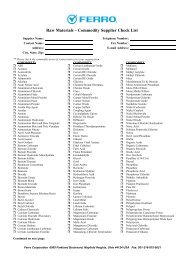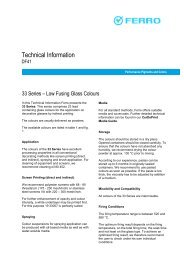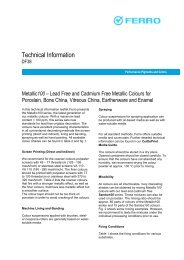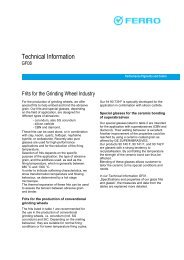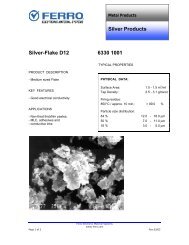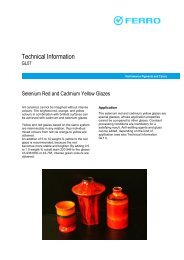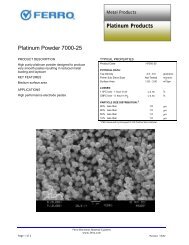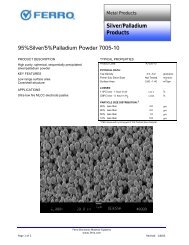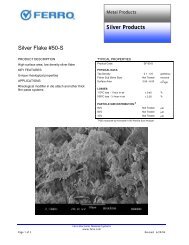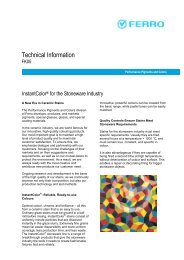LTCC PROCESSING INSTRUCTIONS For Ferro A6 and L8 Tape
LTCC PROCESSING INSTRUCTIONS For Ferro A6 and L8 Tape
LTCC PROCESSING INSTRUCTIONS For Ferro A6 and L8 Tape
Create successful ePaper yourself
Turn your PDF publications into a flip-book with our unique Google optimized e-Paper software.
ased stencils. A vacuum pull through is typically used on the printing stage, <strong>and</strong> backing paper<br />
is typically used for backing the film during the via filling operation. Purpose built bladder type<br />
via filling equipment may also be used with the FERRO <strong>Tape</strong> <strong>and</strong> Via fill paste systems. Precise<br />
via filling conditions will depend on the number, size <strong>and</strong> mix of vias to be filled, <strong>and</strong> should be<br />
determined experimentally.<br />
1.6 DRY<br />
After completion of via filling the parts should be dried (backing paper still supporting the tape)<br />
in conventional drying ovens at a maximum temperature of 70°C for 20 to 30 minutes.<br />
1.7 PRINT CONDUCTORS<br />
Conductors are printed onto the tape using conventional screen printing techniques <strong>and</strong><br />
recommended screens (see individual product data sheets). Conductor prints may be dried in<br />
conventional drying ovens at a maximum temperature of 70°C for 10 minutes.<br />
1.8 DRY<br />
Dry in conventional drying ovens at a maximum temperature of 70°C for 10 to 20 minutes.<br />
1.9 PRINT RESISTORS<br />
All co-fireable resistors are printed onto the unfired tape using #325 screens. Target dried<br />
thickness is 25-28 μm. The resistors should be dried in conventional drying ovens at a<br />
maximum temperature of 70°C for 10 minutes.<br />
1.10 DRY<br />
Dry in conventional drying ovens at a maximum temperature of 70°C for 10 to 20 minutes.<br />
1.11 STACK LAYERS<br />
All layers should be inspected for visual acceptance <strong>and</strong> collated.<br />
1.12 INSERTS FOR CAVITY FORMATION<br />
Some general guidelines are offered in “<strong>Ferro</strong> <strong>LTCC</strong> H<strong>and</strong>ling <strong>and</strong> Design Recommendations.”<br />
These must be followed for best results.<br />
There are four principal types of cavity.<br />
1. Cavity with vertical walls but closed at bottom.<br />
2. Cavity with stepped walls, closed at bottom.<br />
3. Through cavity.



